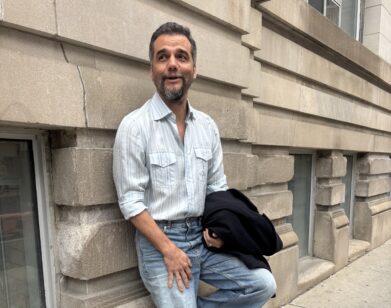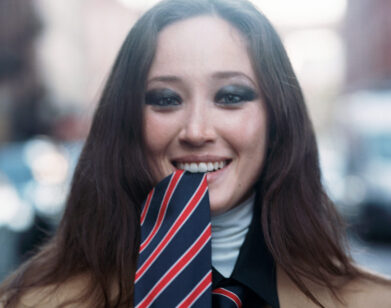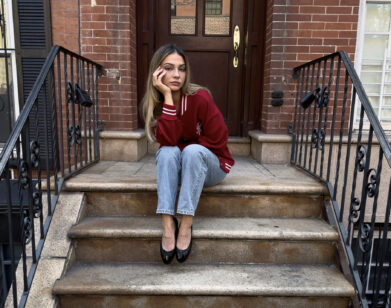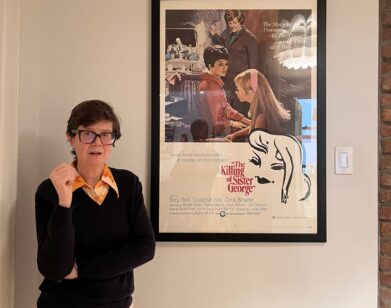Raf Simons and the Ghost of Dior
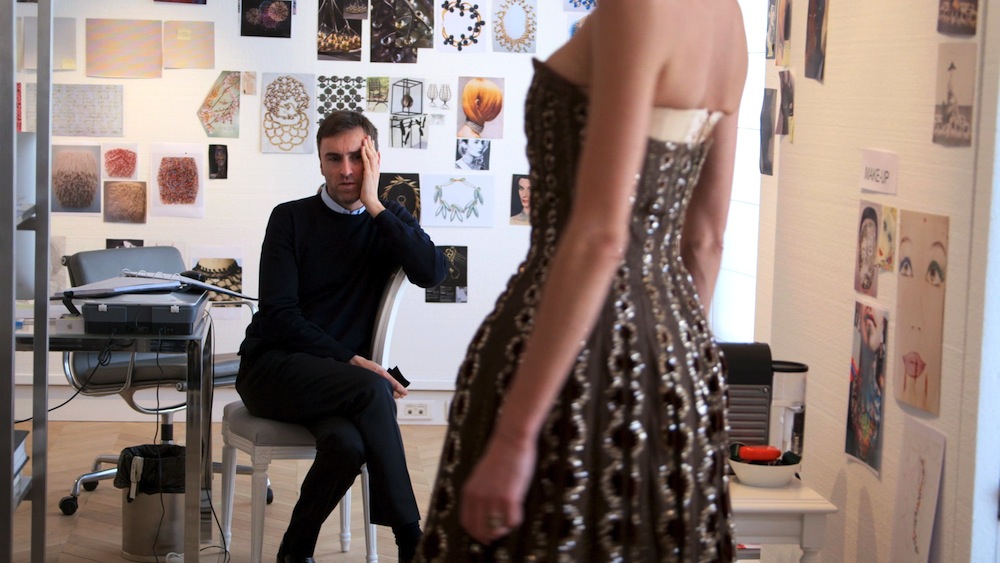
ABOVE: RAF SIMONS IN DIOR AND I. PHOTO COURTESY OF DOGWOOF PICTURES.
Before filmmaker Frédéric Tcheng got the go-ahead to start filming his latest documentary, Dior and I, an account of a new designer in his first months as the artistic director of the global luxury brand, he had to agree to a brief trial period. That designer was, of course, Raf Simons, reputable not just for his iconoclastic menswear work in the ’90s and bringing new life to Jil Sander, but also for his privacy and hesitance towards press. But though the fashion documentary often comes saddled with countless clichés—outsized theatrics, precious egos, and a hearty appetite for drama—Tcheng, leaves all that excess to the wind. Instead, the director, who previously worked on Valentino: The Last Emperor and Diana Vreeland: The Eye Has to Travel, creates a meditative character study of Simons and an engrossing portrait of the creative process, from an idea to its completion.
The film follows Simons’ almost incomprehensible task of completing the fall 2012 haute couture collection, his first for the house, and his first couture collection ever, within eight weeks. The contentious dismissal of Simons’ predecessor, John Galliano, looms, but Tcheng starts fresh, beginning at the Jil Sander alum’s first introduction to the couture atelier workers (some of who have been there for 40 years) at the maison’s Avenue Montaigne headquarters and the marriage of Simons’ future-minded aesthetic with the New Look “femme fleur” legacy of the house.
Where Tcheng really succeeds is in creating a humanistic account of the weight of Simons’ work in the shadow of the brand’s founder. Throughout the documentary, he integrates the voice of the late Christian Dior from his 1956 memoir Christian Dior & I to draw parallels between the two men, both of who struggled to separate their personal selves and personal work from their public personas. Tcheng captures not just a precise genius, but a whole lot of heart from the candid and emotional Simons (he’s near tears when a finished fabric, patterned off an abstract Sterling Ruby painting, arrives to his specifications), teetering on the brink of a monumental career shift that will forever change his future in fashion.
Interview spoke with the Brooklyn-based Tcheng last week, about his fascination with Simons and why, while making a documentary, it’s important to treat it like a love affair.
COLLEEN KELSEY: You started talking to Dior about a film before Raf officially signed on. After Galliano left there were many names in the mix—Riccardo Tisci, Haider Ackermann, Marc Jacobs, Tom Ford… Did you commit to making a documentary before the successor was announced?
FRÉDÉRIC TCHENG: Not exactly. [laughs] I told them that if Raf was going be nominated, I was definitely on board. I wanted to make a film about his arrival. To be honest, I didn’t really know if someone else was going to be picked. It would have been a different story, I think, for me. For some reason, I knew that it was going be Raf. Or I just hoped. It was wishful thinking.
KELSEY: How long had you been following his work for?
TCHENG: On and off for the past five or four years. I remember I bought my first Raf Simons coat, it must have been the winter of 2008 or 9. I wore it to the premiere of the Valentino documentary. It was a sign, I guess. I don’t pay so much attention to fashion. I do follow it on and off, but mostly in connection to the projects that I’m working on. So, when I started to talk to Dior, I really got deep into researching who he was and what his process was like, and that’s when I really got hooked. I knew that he was someone that I wanted to [make a] portrait [of].
KELSEY: How did you approach keeping your autonomy when working with such a protective and powerful house? Luxury brands on this level are quite sacred about their image.
TCHENG: This was definitely one of my biggest concerns at the beginning, and I was pretty transparent about it with Dior. I wasn’t really interested in making a promotional video; what mattered to me was to make a personal film. Also, I consulted a lot of lawyers and tried to figure out what the situation was like. I had never worked in France before, but I was pleasantly surprised to find that in France, the director is granted a lot of autonomy. It was important for me to know that I was going to be able to make the film that I wanted to make.
KELSEY: How difficult was it to get Raf to agree to getting filmed, given his reputation for privacy?
TCHENG: He clearly said no in the beginning. It was such a rollercoaster emotionally for me because, Raf was announced, Dior hadn’t told me; they hadn’t told anyone. It was a big announcement. I see it in the newspaper, and I call [Dior PR head] Olivier Bialobos immediately, and he tells me, [laughs] “Well, you know, don’t jump on a plane yet, because there’s a slight problem. Raf is not keen on the idea of a documentary.” Olivier asked me to send him a little text presenting myself and what I imagined the film would be. It forced me to formalize a lot of the ideas that I had been thinking about. It’s funny, I re-read that text two weeks ago. It pretty much laid the ground for what the film was to become: the encounter the Dior atelier and Raf’s team. As a filmmaker, you look for a story, and the story has to have conflict and a match of opposites. Raf is an industrial designer by training. Most of the ladies in the atelier have been working there for 40 years, so there’s a sense of tradition. Raf is the future. That’s what he’s obsessed with, modernity and the culture of youth, which couldn’t be further from the Dior world in a way.
KELSEY: There’s that one scene where Raf goes to Dior’s childhood home, and he’s talking about reading Dior’s memoirs and how too close for comfort it was for him. Did you start framing the narrative of intercutting with Dior’s memoirs before or after Raf had vocalized his relationship with them?
TCHENG: It’s interesting because in that director’s statement that I drafted even before I met Raf, there was already an element of Christian Dior’s voice in it. I had read the book, and I had completely fallen in love with Christian Dior as a humble and very candid designer, explaining how he worked and how he felt at different stages of the collection. I was interested in how the past would remain present, and the echo between the past and the present. I think it became even more obvious that there was a connection, and Raf was focusing on the first 10 years of the house as an inspiration. So, his relationship with Dior was going to be paramount to his creative process. I went in that direction. It became something else in the editing stage. My editor, Julio Perez, pointed out that the parallels between Raf and Dior were an interesting story, but it needed to go one step further. It needed to be about how Raf is struggling with that legacy and how he can emancipate himself from the shadow of Dior. Then it becomes a real story.
KELSEY: In addition to his relationship with Dior, so many of those women who work in the atelier have worked there for decades, some over 40 years. They have their own relationship with Dior. The subject of his ghost comes up often.
TCHENG: We decided to call the film Dior and I because it was about everyone having a relationship, a deeper, emotional bond, with the founder. That’s what they had in common and that’s what brought them together. I was really impressed to see them be so emotionally involved in their work. Actually in French, sometimes they’re referred to as “les petites mains,” the little hands. But they’re really hearts and minds.
KELSEY: And what was your personal relationship with Raf over the course of the filming? I read that you had to do a trial period. Is that correct?
TCHENG: [laughs] Yeah. After I sent him that letter, he invited me for one week as trial period. He wanted to meet me. He’s very curious, and he’s very generous in a way, which is not necessarily the image that is projected of him in the media. But on a personal level, I find him incredibly thoughtful and curious. He asked me hundreds of questions and tried to get to know me quickly because for him, it really makes a difference, I think, when he knows the person behind the camera.
KELSEY: How did you approach setting boundaries between you and Raf?
TCHENG: Filmmaking is always about keeping the right distance, and it’s always a struggle. You struggle for more access. It’s a little bit of a seduction process, trying to get more access. You’re always thinking, “If I don’t get that scene, it’s gonna ruin the whole film.” It’s a very sort of passionate relationship. It’s almost like being in love, you know? [laughs] It’s very strange. But then in the end, you realize the distance is actually what makes your process possible. You have to keep a little bit of a distance. So, we were not very close. We were not spending every moment of the day with him. Occasionally, Pieter [Mulier, Simons’ right hand man] and Raf would invite me for lunch, but it was a rare occasion. Actually, Raf called me after we finished the movie and showed it in New York last spring, and he gave me a lot of support. He told me that he had wanted to keep a distance throughout the process because he didn’t want to influence my decisions and my judgment. And I thought, “Wow, that’s so thoughtful.” I was a little bit blown away by him saying that. It made sense in retrospect, seeing how he works at Dior. He likes to give people autonomy. I think he understands the creative process, being himself, dealing with it all the time. He understands that people need a certain room.
KELSEY: I think a lot of people have an idea of a fashion designer as an outsized personality with a lot of ego, or a fragile one. Raf is so clearly the opposite of that. He’s powerful when he needs to be, but it’s not about the drama, and you don’t embrace satire, which I think are the crux of a lot of fashion films.
TCHENG: I was very conscious of that. Raf told me something during the shoot. We were talking about different films, documentaries that he’d seen, and he said, “Don’t make me into a caricature.” [laughs] Well, he didn’t say that so directly, but he said, “It’s too bad that sometimes documentaries turn into caricatures. They just latch onto a certain aspect of the personality, and that becomes the main focus.” So, I was very much aware of that. As a filmmaker, it has to be a three-dimensional character. It has to be something more than just a one-dimensional portrait. I definitely tried to steer away from satire. Also, I’m a little bit of an outsider in the fashion world. I don’t go to fashion parties or have too many fashion friends or anything. It’s not my world. I try to approach fashion from my point of view, which is that of the creative process. For me, whether you make a film or you make a collection, there are a lot of elements in common. I don’t really engage in sort of the image-driven culture that we live in. I’m not on Instagram. I feel like fashion has become… I guess it’s always been about image, but now that the culture is about image, fashion is really using those tools more and more. It was a conscious decision to steer away from that and sort of show a more realistic, human side of it.
KELSEY: This collection was critically successful, but when you were making the film, did you have any idea of how important it was going to be for Raf and his career?
TCHENG: I had an instinct that this was going to be a life-changing collection for him. I approached it not so much from the fashion history point of view; I really tried to approach it from an emotional point of view. I knew that he was going to be stepping into a world that’s much more exposed. Knowing his reluctance to publicity, I knew that this was going to be a threshold into a new life. That’s what I was trying to make the film about, the transformation. In a film, you always try to have your main character be changed by the end. I was hoping for that, and it really happened on a level that I didn’t really anticipate. His relationship to the exposure of the show was brilliant, beyond what I expected. It was really emotional. He was trusting enough to show his vulnerability on camera. As a filmmaker, I can’t ask for a better gift.
DIOR AND I IS OUT IN LIMITED RELEASE TODAY AT FILM FORUM AND THE FILM SOCIETY OF LINCOLN CENTER IN NEW YORK.

